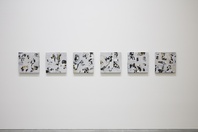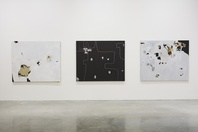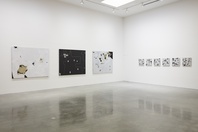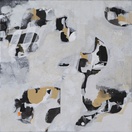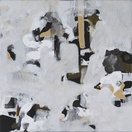Karen Mills
Darwin
2017
Displayed 2017 at Museum of Contemporary Art Australia

Karen Mills
Born 1960, Katherine, Northern Territory. Lives and works Darwin
Balanggarra, Kimberley region
Karen Mills mainly works with painting to investigate themes of identity, connection and disconnection with her Aboriginal heritage and the timeless relationship that Aboriginal peoples maintain with their ancestral Country despite recent histories of dispossession and displacement. Her abstract paintings are generally landscape-based, inspired by her experience and memory of Country. These works capture a sense of the rich history and survival of Aboriginal culture hidden beneath layers of sediment.
Artist text
by Kelly McDonald
Floodline (2016) is a series of six paintings by Karen Mills depicting the floodplains that surround Sturt Creek in the desert of the East Kimberley in Western Australia. As the primary river formation in a sparsely populated arid landscape, Sturt Creek floods and recedes with the seasons. There are tens of thousands of years of human occupation in this landscape, currently populated by outlying Aboriginal communities and a small number of vastly distributed cattle stations.
In the canvases, geometric forms resembling rock formations rise from creek beds, with the ‘milky water, either inundating the floodplain or receding’. (1) Mills describes the colour of the water as
milky-white from clay particles washed into the creek when it rains. And then, when the water moves over the floodplain and dries out, the clay forms new layers of soil.
The use of ochre in the underlying layers invests the paintings with the physical presence of Country. Rather than depicting ‘direct landscapes’, Mills paints ‘a synthesis of many observations and memories expressed in paint’. These paintings could be aerial views; the landscape seen from directly above with abstract forms punctuating expansive gaps, reflecting the wide, open spaces of the East Kimberley.
The Floodline works depict landscape, however, they act as self-portraits. Mills is a stolen generation artist, adopted from her mother in Elliott in the Northern Territory and raised predominantly in Adelaide. This western side of her life is evident in the artistic influence of Jackson Pollock (2) and abstract expressionism, in the form of her paintings and mark-making. Though these are painted landscapes, they could easily be abstracted works, more symbolic than figurative. They are imagined, reimagined, remembered and composite landscapes.
The act of painting landscapes is one of discovery and an expression of identity and exploration. Mills talks about her desire for Country (3) and her practice is a way of learning and coming to know the land. She is also expressing a desire for its beauty and the history it holds. While the negative spaces mirror the vastness of the landscape around Sturt Creek, they also speak to gaps in the artist’s knowledge of her own culture.
Mills’ choice of materials allows her to ‘create more texture with the coarseness of the hand-ground ochre compared to [that of] the machine-ground pigments’. Fine coats of milky paint are built up, often leaving bubbles in the surface of the canvas, as though the chalky water was washing over the riverbed. The colours are of the earth – browns, blacks, tans, greys and oranges, and the milky-white of clay. This layering of paint and colour adds depth to Mills’ formations and echoes the layering of time; the accrual of deep history in Country.
Notes
(1) Unless otherwise noted, all quotes are from interviews between the artist and author, 14 October and 24 November 2016.
(2) Sara Sweet, ‘Profile: Karen Mills’, Artist Profile, iss.36, 2016, p.75.
(3) Karen Mills, email to the author, 14 October 2016.
